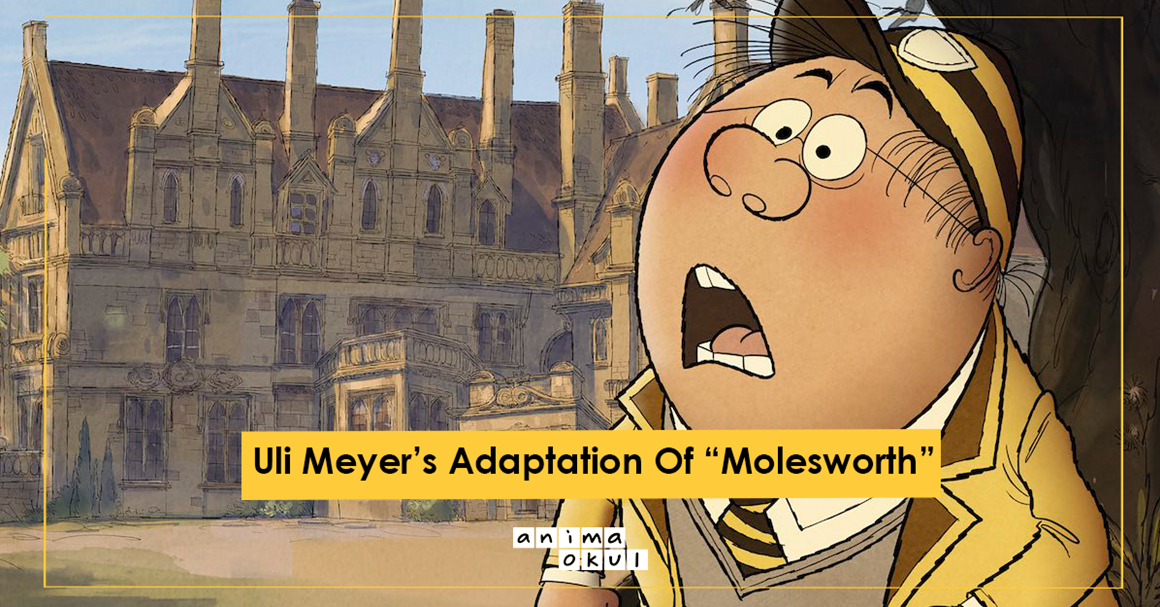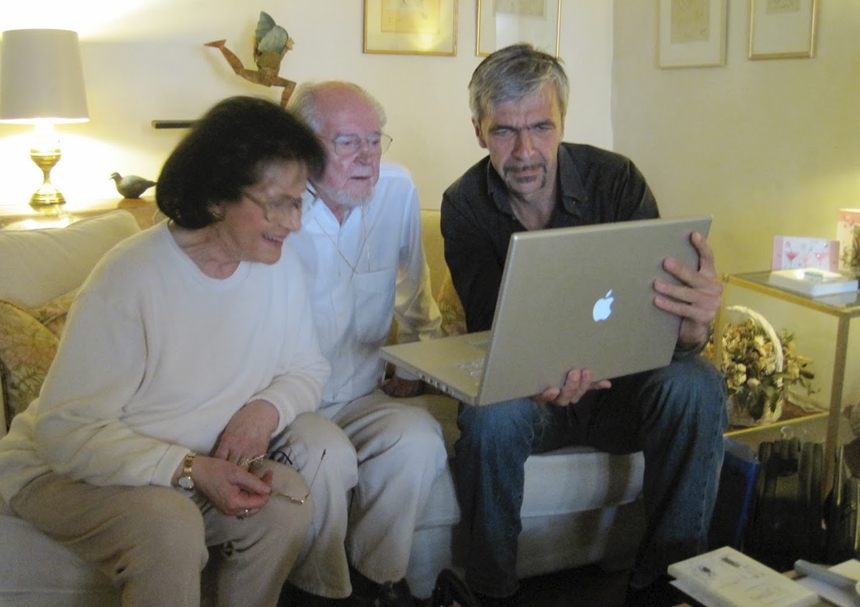ULI MEYER’S ADAPTATION OF “MOLESWORTH”

The British artist has worked for years on animated versions of Ronald Searle's famous illustration character. But when he saw Uli Meyer's first adaptation work, he decided it was okay to just have the Searle character animated by Meyer.
Searle died in 2011, he would have turned 100 this year had he lived. Meyer never forgot his words. When the chance to practice one of the illustrator's most beloved works arose, he immediately jumped at the opportunity. The film is still in the making, and has now been submitted to Cartoon Movie, Europe's most important film submission platform. In the presentation, the trailer was shared exclusively with Cartoon Brew.
The film is based on characters written by Geoffrey Williams and drawn by Ronald Searle in 1950. In the still popular books, St. It is about the abuse of a child living in Custord. The story, which contains anecdotes about school life and British society, does not have a linear narrative. So Meyer penned an original story so Bafta-nominated Keiron Self and Giles New could write the screenplay.
Leaving his native Germany in the 1980s, Meyer settled in London and became famous as a character animator. After working on the movie "Who Framed Roger Rabbit", he founded his own studio, Uli Meyer Animation, in 1991. He was already familiar with Searle's work, introduced to him by his friend Han Bacher. Years later, Meyer developed a personal relationship with Searle through another friend, industry artist Matt Jone, who blogs about Searle in his spare time.
To produce Molesworth, Uli Meyer Studios partnered with British animation studio Lupus film, which has a strong track record in literary adaptations. Luxembourg's Melusine Productions is also a co-producer. Camilla Deakin and Ruth Fielding are producing for Lupus, and Stéphan Roelants is producing for Melusine. British comedian Matt Lucas (Alice in Wonderland) leads the Molesworth voice cast.
Meyer and Deakin talked about the challenges of creating Searlesque animation, handmade animation, and producing British film in the shadow of Brexit.
Why did you decide to adapt Molesworth now?
Meyer: It's all about the with ST. Tirian animation. I went to visit him in the south of France, and he was really excited about it. He had called his agency and said that if I wanted to use his work to make a movie, he would allow it. In fact, I am the only person with explicit permission to work with Searle's characters.
I returned to London and St. All rights to Trinian have been permanently sold to Ealing Studios. Unfortunately, animation rights are also included in this. I finally decided to look into Molesworth stories because it was really popular back then and still is to some people...
Deikin: At Lupus Studios we made a feature film based on Raymond Brigg's graphic novel Ethel & Ernest. This was the first 2D hand-drawn animated film made in the UK in the last two decades. Uli contacted us and came to visit our studio and we loved what he saw.
Lupus is also adaptations of known novels that we specialize in, and when she told me about Molesworth, I was thrilled because I've been a fan of this book series since I was a teenager. Ethel&Ernest we made was an adult movie, I thought how fun it would be to make this comedy that the whole family can watch.
I thought the timing was just right, because our success with our television shows and film has led us to believe that there is definitely an audience for traditional animation. Our Christmas specials for Channel 4 are each among the highest rated or highest rated programs of any genre on that channel.
Searle's characters have been animated in the past: Energetically Yours, Dick Deadeye. Do you think his style was adapted successfully?
Meyer: Searle gave me the St. He said he liked Trinian's test. There was a man named Ivor Wood, an animator who did five-second animations in the 1970s. He created Searle's style really well. I think Searle was happy with the Energetically Yours adaptation, but not so happy for Dick Deadeye.
I can tell you that his style was very difficult to imitate, especially when his work started to become more expressive and experimental in the 1970s. Like handwriting. Searle drew all the layouts for Dick Deadeye, he was a little disappointed in his animation work. On the other hand, it was a low budget movie.
Molesworth is a character from the 1950s and I think his drawing style from that period is easier to apply. That being said, one can be more creative if they make a Searle-style film alone. I had to find a way for an entire team to adopt this style.
The Molesworth teaser isn't 100% Searle. I call it "Searlesque". It is impossible to draw exactly like him, but you can understand the essence of the characters and I found a drawing method that can be adopted by assistants. It has to look handmade. I want to avoid as many cg elements as possible.
Will you refer to these previous films during production at Molesworth?
Meyer: I have an original Searle Art collection. I intend to reference Searle and develop my own version of his world.
What's the fun of adapting the Searle style?
Meyer: I think my own style of drawing has always been a bit Searlesque, and you're always attracted to artists you feel close to. From the first time I saw Searle's drawings, I felt there was something there that touched me.
When is the first?
Meyer: I met Hans Bacher and Harald Siepermann in Düsseldorf in the 1980s. I had just graduated from school and we started a small company called The Mad Tea Party. I was a young kid, making money from advertising. Hans had a large Searle library, and that's when I realized that I needed to know his work in detail.
How will you adapt her work without using too many "boiling line" techniques?
Mayer: You can clearly see in the trailer that this line is alive. A mix of boling line technique and being controlled. If you like, you can see that Searle's own line boils down much less. His drawings are incredibly structured. Beneath all that wild, scratchy ink streak are some really well-constructed shapes. I don't think if you did a whole movie frame by frame and used a lot of "boling line" technique, you wouldn't be able to sit on it. So I had to find a way to imitate your style and not be too wild
Will you be working entirely on a tablet?
Mayer: I did St Trinian's test with ink over cel animation. I then did another test in TVPaint and compared both and saw no difference. We plan to make the entire movie Molesworth on tablets; I don't think you can find a crew big enough to remove frosted glass and ink marks. The trailer was drawn in TVPaint. We used many hand-painted, hand-drawn textures to create the background. All characters and scenes were drawn digitally.

How easy is it to find a 2D animation team nowadays?
Mayer:I was talking to the Klaus crew recently, and they said they couldn't find many stage performers.
Deakin: It's funny to hear, because we had a similar problem on the 2019 TV special project The Tiger Who Came to Tea. But we have one or two really good layout artists. It's just that people with these skills are suddenly in greater demand.
We have successfully teamed up for Ethel & Ernest and we do all 30 minute episodes in-house. We have a full team of 50 or 60 animators working for about nine months. The talent is out there, but the real challenge is that there are no other 2D movies to team up at the same time. Because in Ireland, France, Spain, increasingly few films are made in traditional 2D and TVPaint. Top-notch 2D animators with high skills are in demand, and they tend to be a highly mobile workforce or work from home
Mayer: I have many animation friends all over the world. I had a list of animators who wanted to take part in this movie, that I enjoyed working with. I think a lot of new, incredible talent has emerged, especially in Klaus. I think there is a revival in 2D animation: if you are very good, you can have a good career.
Deakin: I agree with you. We had a little trouble when we did Ethel & Ernest. That's why we've reached out to all the animation schools in the UK that have 2D courses and have programmed a joint training with ScreenSkills. We trained them at TVPaint, and I must say, some of the people who came out of these shows are now among the best animators in the industry.
Source: Cartoon Brew